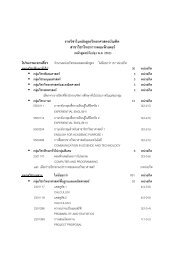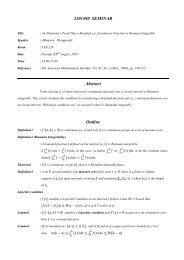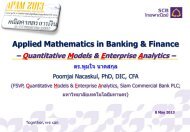Lecture Notes Topology (2301631) Phichet Chaoha Department of ...
Lecture Notes Topology (2301631) Phichet Chaoha Department of ...
Lecture Notes Topology (2301631) Phichet Chaoha Department of ...
Create successful ePaper yourself
Turn your PDF publications into a flip-book with our unique Google optimized e-Paper software.
30 <strong>Topology</strong> (<strong>2301631</strong>)<br />
d x<br />
X ♣ ♣ ♣ ♣ ♣ ♣ ♣ ♣ ♣ ♣ ♣ ♣ ♣ ♣ ♣ ♣ ♣ ♣ ♣✲♣ ♣ R + 0<br />
◗<br />
ι ◗◗ ✑ ✑✸<br />
d {x}×X<br />
{x} × X<br />
where ι(y) = (x, y) for each y ∈ X. Clearly, d x is continuous and hence B d (x; r) =<br />
d −1<br />
x ([0, r)) is open in X; i.e., B d (x; r) ∈ τ. □<br />
Theorem 1.142. The converse <strong>of</strong> the sequence lemma holds in a metric space.<br />
Pro<strong>of</strong>. Let (X, d) be a metric space, A ⊆ X and a ∈ A. Then, we have<br />
B d (a; 1 n )∩A ≠ ∅ for each n ∈ N. By the axiom <strong>of</strong> choice, we obtain a sequence (a n)<br />
in A such that a n ∈ B d (a; 1 n ) ∩ A for each n ∈ N. To show that (a n) converges to a,<br />
we let U be an neighborhood <strong>of</strong> a. Since the metric topology on X is generated by<br />
open balls, there exits ϵ > 0 such that B d (a; ϵ) ⊆ U. By choosing N ∈ N such that<br />
1<br />
N < ϵ, we have a n ∈ B d (a; 1 n ) ∩ A ⊆ B d(a; 1 N ) ∩ A ⊆ B d(a; ϵ) ∩ A ⊆ U ∩ A ⊆ U for<br />
all n ≥ N. This proves that (a n ) → a as desired.<br />
□<br />
Theorem 1.143. Let f : X → Y be a map <strong>of</strong> spaces, where X satisfies the<br />
converse <strong>of</strong> the sequence lemma. Then, f is continuous iff for any x ∈ X and any<br />
sequence (x n ) converging x, the sequence (f(x n )) converges to f(x).<br />
Pro<strong>of</strong>. (⇒) Follows from Exercise 1.95(1).<br />
(⇐) Let A ⊆ X and y ∈ f(A). Then y = f(x) for some x ∈ A. Since X<br />
satisfies the converse <strong>of</strong> the sequence lemma, there exists a sequence (a n ) in A<br />
converging to x. By the assumption, the sequence (f(a n )) (in f(A)) converges<br />
to f(x). Therefore, by the sequence lemma, y = f(x) ∈ f(A). It follows that<br />
f(A) ⊆ f(A) which implies the continuity <strong>of</strong> f.<br />
□<br />
Corollary 1.144. The previous theorem is true when X is metrizable.<br />
Example 1.145. The space S Ω is not metrizable because it does not satisfy<br />
the converse <strong>of</strong> the sequence lemma.<br />
Definition 1.146. Two metrics d 1 and d 2 on a set X are said to be (topologically)<br />
equivalent if d 1 and d 2 induce the same metric topology on X.<br />
Exercise 1.147. Let d and ρ be metrics on a set X. If there exist positive real<br />
numbers a, b and c such that for any x, y ∈ X,<br />
prove that d and ρ are equivalent.<br />
ad(x, y) ≤ bρ(x, y) ≤ cd(x, y),<br />
Exercise 1.148. On R n , we can define the square metric ρ and the taxicab<br />
metric d t by<br />
• ρ(x, y) = max{|x 1 − y 1 |, . . . , |x n − y n |}<br />
• d t (x, y) = ∑ n<br />
i=1 |x i − y i |<br />
for any x, y ∈ R n . Prove that ρ and d t are really metrics on R n , and both are<br />
equivalent to the euclidean metric d. [Hint : use the previous exercise]<br />
Unfortunately, for the metrizability <strong>of</strong> R ω , we do not have obvious generalizations<br />
<strong>of</strong> the d or d t because <strong>of</strong> the convergence issue. However, we can modify ρ to<br />
get the bounded version by letting<br />
ρ(x, y) = sup{d(x i , y i ) | i ∈ N}





